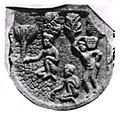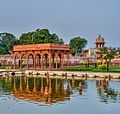Portal:Gardening
The Gardening Portal

Gardening is the process of growing plants for their vegetables, fruits, flowers, herbs, and appearances within a designated space. Gardens fulfill a wide assortment of purposes, notably the production of aesthetically pleasing areas, medicines, cosmetics, dyes, foods, poisons, wildlife habitats, and saleable goods (see market gardening). People often partake in gardening for its therapeutic, health, educational, cultural, philosophical, environmental, and religious benefits. Gardening varies in scale from the 800 hectare Versailles gardens down to container gardens grown inside. Gardens take many forms, some only contain one type of plant while others involve a complex assortment of plants with no particular order. (Full article...)
Horticulture is the science, technology, art, and business of cultivating and using plants to improve human life. Horticulturists and Horticultural Scientists create global solutions for safe, sustainable, nutritious food and healthy, restorative, and beautiful environments. This definition is seen in its etymology, which is derived from the Latin words hortus, which means "garden" and cultura which means "to cultivate". There are various divisions of horticulture because plants are grown for a variety of purposes. These divisions include, but are not limited to: gardening, plant production/propagation, arboriculture, landscaping, floriculture and turf maintenance. For each of these, there are various professions, aspects, tools used and associated challenges; Each requiring highly specialized skills and knowledge of the horticulturist. (Full article...)
General images -
Selected article -

Plant nutrition is the study of the chemical elements and compounds necessary for plant growth and reproduction, plant metabolism and their external supply. In its absence the plant is unable to complete a normal life cycle, or that the element is part of some essential plant constituent or metabolite. This is in accordance with Justus von Liebig's law of the minimum. The total essential plant nutrients include seventeen different elements: carbon, oxygen and hydrogen which are absorbed from the air, whereas other nutrients including nitrogen are typically obtained from the soil (exceptions include some parasitic or carnivorous plants).
Plants must obtain the following mineral nutrients from their growing medium:
- The macronutrients: nitrogen (N), phosphorus (P), potassium (K), calcium (Ca), sulfur (S), magnesium (Mg), carbon (C), hydrogen (H), oxygen (O)
- The micronutrients (or trace minerals): iron (Fe), boron (B), chlorine (Cl), manganese (Mn), zinc (Zn), copper (Cu), molybdenum (Mo), nickel (Ni) (Full article...)
Selected image
Related portals
Did you know -
- ... that Nizza in central Frankfurt is one of the largest gardens of Mediterranean plants north of the Alps, thanks to its very warm microclimate?
- ... that in 1896, the New York Driving Club was sued for damaging their neighbor's garden?
- ... that in 2023, a sculpture garden in Praunheim displayed abstract works by Hans Steinbrenner from different periods of his life, and corresponding works by his friends and students?
- ... that Mel Bartholomew, who developed the time-saving square foot gardening method, said that he gardened "with a salad bowl in mind, not a wheelbarrow"?
- ... that the New Zealand Geographic Board initially rejected the name of the Garden of Eden Ice Plateau for being biblical in origin?
- ... that Nusrati attributes the virtues of a good ruler to his patron Ali Adil Shah II in The Rose Garden of Love?
- ... that in garden history, a wilderness is a highly artificial and formalized type of woodland, forming a section of a large garden?
- ... that a guerrilla garden established atop an abandoned railroad in Long Island City became legally recognized by the MTA?
Things you can do
- This list is transcluded from the tasks list page. To edit the list, click here
 |
Here are some tasks awaiting attention:
|
WikiProjects
Topics
Categories
Associated Wikimedia
The following Wikimedia Foundation sister projects provide more on this subject:
-
Commons
Free media repository -
Wikibooks
Free textbooks and manuals -
Wikidata
Free knowledge base -
Wikinews
Free-content news -
Wikiquote
Collection of quotations -
Wikisource
Free-content library -
Wikiversity
Free learning tools -
Wiktionary
Dictionary and thesaurus


































































































